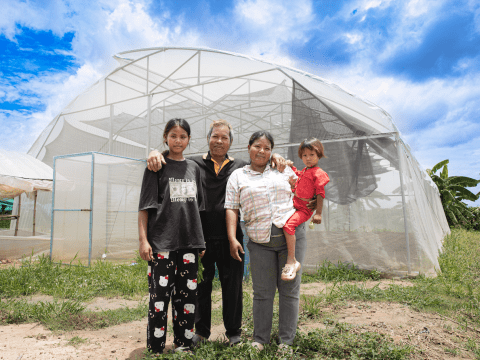Building community resilience through climate-smart agriculture

Banteay Meanchey province, located in Northwest Cambodia, has long struggled with the dual threats of flooding and drought – challenges that are being intensified by climate change. Unpredictable rainfall and rising temperatures continue to disrupt rice farming, damage homes and infrastructure, and displace families, deepening economic hardship across the region.
Yet in the middle of these challenges, smallholder families are transforming their futures. With funding from the German Federal Ministry for Economic Cooperation and Development (BMZ) and technical support from World Vision Germany, the Improving Food and Nutrition Security and Resilience of Vulnerable Farmers (IFNSR) project is helping vulnerable communities adapt and thrive.
Led by World Vision International in Cambodia (WVI-C) in collaboration with local partners Wathnakpheap and Sovann Phoum, the project has reached over 900 households across 73 villages. Through a holistic approach – combining climate-resilient agriculture, nutrition education, and improved market access – the initiative is building lasting resilience and empowering families to rise above adversity.
Reunited Family
After years of working in unregulated, low-wage jobs, in Thailand, Chay returned home with his wife and daughters to a plot of land surrounded by rice paddies. Although he had no formal agricultural training, his eagerness to cultivate the land let to his family being selected to join the IFNSR initiative.
They received farming inputs and training in climate-resilient practices. They built net houses to grow cabbage and Chinese kale, and planted fruit trees along their property to protect their fields from roaming cattle. Chay also makes use of nearby water sources, harvesting wild vegetables, such as morning glory, while his wife sources local food from neighbouring vendors.
Over time, their home evolved into a small collection point for vegetables, crabs and snails, which the family sells at a market 10 kilometres away. The additional income has enable them to raise livestock, expand their farming efforts, and improve their children’s wellbeing.
Their ninth-grade daughter dreams of becoming a teacher. Every morning before school, she helps harvest produce for the market. “I’ll never go back to Thailand,” shares Chay. “This land, these crops, are our future.”
Ensuring Nutrition for the Next Generation
In another village, the families of Sreytoch and Sreythom are raising young children and relying on seasonal vegetables and small-scale poultry farming to nourish and sustain themselves. Though modest, their flocks of ducks and chickens produce 4 to 8 eggs per day, consistently providing protein-rich meals for their children and occasional income through meat sales.
“Our children love fried eggs,” says Sreytoch with a quiet smile. “They’re eating better now.”
By selling eggs and poultry during peak demand periods, these families are able to cover essential expenses such as school fees and household items—while ensuring their children have regular, nutritious meals.
Investing in Farming and Education
For another couple, farming has become a source of both income and inspiration. With support from the project, training in agricultural techniques for both the dry and wet seasons, and their own self-directed learning – from YouTube tutorials to peer exchanges – Natt and his wife have diversified their crops and increased their yields. In addition to growing vegetables in net houses, they have also successfully cultivated water lilies and other high-demand produce.
Their harvest not only feed themselves and their grandchild – who is under five years old – but its sale has also boosted their income and made a meaningful difference in their lives. They are deeply proud that their farming success has enabled their youngest daughter to reach her second year of university, where she is studying finance.
“We’re always learning and improving,” Natt explains. “And we share that knowledge with our neighbours.”
The couple's primary strategy for increasing incomes is using their knowledge of which vegetables to grow and when to plant them in order to meet market demand.
Market Linkage for Better Prices
This initiative goes beyond traditional farming support—it builds long-term resilience by equipping vulnerable households with the tools, knowledge, and market access they need to thrive.
A total of 900 households have been trained in climate-smart agriculture and poultry rearing, enabling them to adapt to changing weather patterns and produce food sustainably. To strengthen their production, the project distributed essential inputs, including seeds, fruit trees, livestock, and water systems. Infrastructure investments have also been significant – 23 greenhouses were constructed, and farming tools were provided to improve crop quality and output. An additional 246 families received livestock support, while 82 households were equipped with fruit trees to diversify their agricultural income.
Crucially, the project strengthened eight agricultural cooperatives. These cooperatives help farmers access markets, negotiate better prices, reduce input costs, and operate more effectively as businesses.
"When our farmers grow vegetables, we assist them in finding partners to purchase their yield. We have both local and external buyers. Additionally, we organise farming field days and marketing events to display and promote all types of local produce, with support from our government's provincial officers," said Kroeurn, deputy leader of Khnhe Chouk Chey Agriculture Cooperative.
The IFNSR project demonstrates that with the right support, vulnerable communities can overcome systemic challenges and build stronger, healthier, and more resilient futures. From food security to education, from traditional farming to smart agricultural practices, Cambodian farmers are reclaiming their futures, with a little help from partners who believe in their potential.
Their stories are a powerful testament to what’s possible when compassion, investment, and local leadership come together.